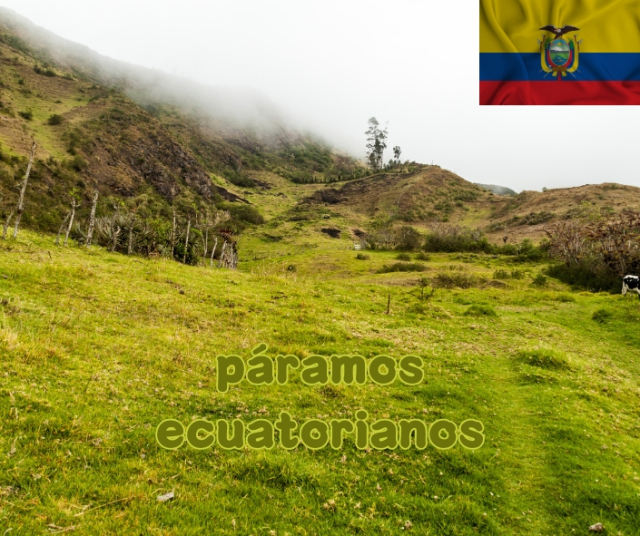The paramos of Ecuador represent one of the most unique and valuable ecosystems in the country, playing a crucial role in regional ecology, biodiversity conservation and the life of local communities. In this article, we will delve into the wonder of the Ecuadorian paramos, exploring their importance, characteristics, biodiversity and the challenges they face today.
The Paramos: Their Importance and Meaning.
The moors are high mountain ecosystems that are located between the limits of the montane forest and the perpetual snow line. With their distinctive high-altitude vegetation and extreme climatic conditions, páramos play a vital role in regulating the water cycle, sequestering carbon and protecting biodiversity. In Ecuador, these ecosystems stretch across the Andes mountain range, encompassing a vast expanse of highlands that are home to an incredible variety of flora and fauna. Next, we will explore some of the most notable types of paramos found in Ecuador:
Herbaceous Moors.
Herbaceous paramos are one of the most common types of paramos found in Ecuador. These ecosystems are dominated by dense vegetation of herbs and grasses, such as pajonales, which cover extensive areas of the Andean highlands. The herbaceous moors are known for their unique biodiversity, with a wide variety of plant species adapted to the harsh high mountain climatic conditions. Among the most emblematic species are the frailejones (Espeletia spp.), giant plants that form an important part of the landscape of the moors.
Shrubby Moors.
Shrub paramos are another type of common ecosystem in Ecuador, characterized by the predominant presence of shrubs and bushes adapted to the cold and humid conditions of the Andean heights. These moors are typically found in drier areas exposed to strong winds, where shrubby vegetation offers protection against soil erosion and nutrient loss. Among the most common shrubs in the shrubby paramos are the chuquiragua (Chuquiraga jussieui) and the chuquirahua (Baccharis spp.), which are endemic species to the Andean region.
Wooded Moors.
Wooded paramos, also known as polylepis forests, are unique ecosystems found in the highest parts of the Andean mountains of Ecuador. These forests are dominated by the genus Polylepis, which includes several species of trees adapted to extreme high altitude conditions. Forested paramos are important for biodiversity conservation as they are home to a variety of endemic and endangered species of flora and fauna, including mammals such as the spectacled bear and birds such as the Andean condor.
High Moors.
High altitude paramos are ecosystems found on the highest peaks of the Andean mountains, where climatic conditions are extremely harsh and soil is scarce. These moors are dominated by low-growing vegetation adapted to alpine conditions, such as mosses, lichens and cold-resistant herbaceous species. Despite the inhospitable conditions, the high-altitude moors are home to unique biodiversity, with species adapted to life at height, such as the moorland rat (Thomasomys spp.) and the glass frog (Pristimantis spp.).
Transitional Paramos.
In addition to these main types of paramos, Ecuador is also home to transitional paramos, which are found in transition zones between paramo ecosystems and montane forests. These moors are of great ecological importance, since they act as biological corridors that connect different habitats and allow the flow of species between them. The transitional paramos are areas of high biodiversity, with a mix of flora and fauna species characteristic of both the paramos and montane forests.
Exploring the Altitude: Geographic and Climatic Characteristics.
The Ecuadorian paramos are found at altitudes ranging from 3,000 to 4,000 meters above sea level, with some areas reaching even higher altitudes. These mountain landscapes are dominated by vegetation adapted to the harsh climatic conditions, including species such as frailejones, pajonales, yarbales and polylepis forests. The climate in the moors is cool and humid, with temperatures that can drop below zero at night and a marked rainy season between the months of October and May.
The Ecological Importance of the Moors: Ecosystem Services and Biodiversity.
Ecuador's paramos are a crucial source of life-sustaining ecosystem services in the country's lowlands. They act as natural water reservoirs, capturing and storing moisture from the clouds and gradually releasing it throughout the year. This water feeds the rivers and streams that descend into the lowlands, providing water for agriculture, human consumption, and hydroelectric power generation. In addition, the moors are home to unique biodiversity, with numerous endemic species of plants, birds and mammals that depend on these ecosystems for their survival.
The Relationship between the Moors and Local Communities.
The communities that live near the paramos depend largely on these ecosystems for their subsistence and well-being. Agriculture is a common activity in the highlands, with crops such as potatoes, corn, barley and quinoa being grown on the mountain slopes. In addition, many communities use the natural resources of the páramos, such as firewood, water and grasslands, to meet their daily needs. The conservation of the paramos is essential to guarantee the sustainability of these communities and protect their traditional way of life.
Threats and Challenges: Protecting the Moors for the Future.
Despite their ecological and cultural importance, Ecuador's paramos face a number of threats, including deforestation, agricultural expansion, illegal mining, and climate change. Habitat fragmentation and loss of biodiversity are growing concerns, as many endemic species are threatened with extinction due to degradation of their natural habitat. To address these challenges, a number of conservation measures have been implemented, including the creation of protected areas and the promotion of sustainable management practices.
The paramos of Ecuador are natural treasures of incalculable value, playing a vital role in the regional ecology and the life of local communities. Their conservation and protection are essential to ensure a sustainable future for future generations and to preserve the beauty and biodiversity of these unique ecosystems. By valuing and protecting the paramos, Ecuador is defending not only its natural heritage, but also the health and well-being of its citizens and the planet as a whole.
